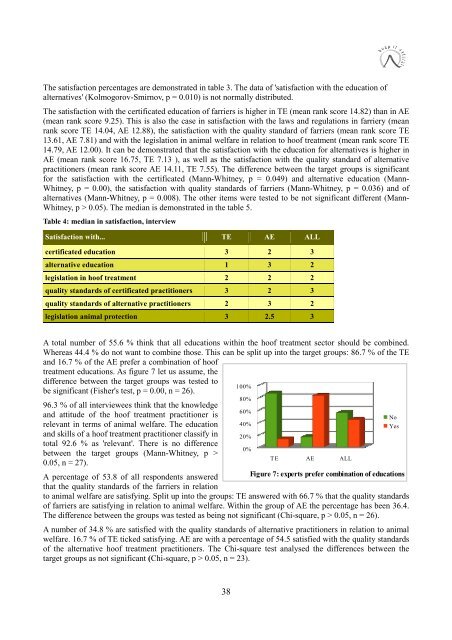Bachelor Thesis - Christina Kuenen - Hufpfleger
Bachelor Thesis - Christina Kuenen - Hufpfleger
Bachelor Thesis - Christina Kuenen - Hufpfleger
Create successful ePaper yourself
Turn your PDF publications into a flip-book with our unique Google optimized e-Paper software.
The satisfaction percentages are demonstrated in table 3. The data of 'satisfaction with the education of<br />
alternatives' (Kolmogorov-Smirnov, p = 0.010) is not normally distributed.<br />
The satisfaction with the certificated education of farriers is higher in TE (mean rank score 14.82) than in AE<br />
(mean rank score 9.25). This is also the case in satisfaction with the laws and regulations in farriery (mean<br />
rank score TE 14.04, AE 12.88), the satisfaction with the quality standard of farriers (mean rank score TE<br />
13.61, AE 7.81) and with the legislation in animal welfare in relation to hoof treatment (mean rank score TE<br />
14.79, AE 12.00). It can be demonstrated that the satisfaction with the education for alternatives is higher in<br />
AE (mean rank score 16.75, TE 7.13 ), as well as the satisfaction with the quality standard of alternative<br />
practitioners (mean rank score AE 14.11, TE 7.55). The difference between the target groups is significant<br />
for the satisfaction with the certificated (Mann-Whitney, p = 0.049) and alternative education (Mann-<br />
Whitney, p = 0.00), the satisfaction with quality standards of farriers (Mann-Whitney, p = 0.036) and of<br />
alternatives (Mann-Whitney, p = 0.008). The other items were tested to be not significant different (Mann-<br />
Whitney, p > 0.05). The median is demonstrated in the table 5.<br />
Table 4: median in satisfaction, interview<br />
Satisfaction with... TE AE ALL<br />
certificated education 3 2 3<br />
alternative education 1 3 2<br />
legislation in hoof treatment 2 2 2<br />
quality standards of certificated practitioners 3 2 3<br />
quality standards of alternative practitioners 2 3 2<br />
legislation animal protection 3 2.5 3<br />
A total number of 55.6 % think that all educations within the hoof treatment sector should be combined.<br />
Whereas 44.4 % do not want to combine those. This can be split up into the target groups: 86.7 % of the TE<br />
and 16.7 % of the AE prefer a combination of hoof<br />
treatment educations. As figure 7 let us assume, the<br />
difference between the target groups was tested to<br />
100%<br />
be significant (Fisher's test, p = 0.00, n = 26).<br />
96.3 % of all interviewees think that the knowledge<br />
60%<br />
and attitude of the hoof treatment practitioner is<br />
No<br />
relevant in terms of animal welfare. The education 40%<br />
Yes<br />
and skills of a hoof treatment practitioner classify in 20%<br />
total 92.6 % as 'relevant'. There is no difference<br />
0%<br />
between the target groups (Mann-Whitney, p ><br />
T E AE ALL<br />
0.05, n = 27).<br />
A percentage of 53.8 of all respondents answered Figure 7: experts prefer combination of educations<br />
that the quality standards of the farriers in relation<br />
to animal welfare are satisfying. Split up into the groups: TE answered with 66.7 % that the quality standards<br />
of farriers are satisfying in relation to animal welfare. Within the group of AE the percentage has been 36.4.<br />
The difference between the groups was tested as being not significant (Chi-square, p > 0.05, n = 26).<br />
A number of 34.8 % are satisfied with the quality standards of alternative practitioners in relation to animal<br />
welfare. 16.7 % of TE ticked satisfying. AE are with a percentage of 54.5 satisfied with the quality standards<br />
of the alternative hoof treatment practitioners. The Chi-square test analysed the differences between the<br />
target groups as not significant (Chi-square, p > 0.05, n = 23).<br />
80%<br />
38


